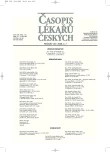Occurrence of the Yeast and Filamentous Fungi in Haematological Patients during 2002 to August 2005
Authors:
A. Jedličková; M. Hajíčková; P. Olišarová
Authors‘ workplace:
Klinická mikrobiologie a ATB centrum VFN, Praha
; Laboratoř mykologie VFN, Praha
; ÚKBLD 1. LF UK, Praha
Published in:
Čas. Lék. čes. 2006; 145: 567-570
Category:
Original Article
Overview
Background.
The number of diseases caused by yeast and fungi has been increasing recently. The primary disease is caused by dermatophytes and Cryptococcus neoformans. Other types of yeast and fungi can cause secondary infections of patients with predisposition factors. Among the mycotic diseases diagnosed in our laboratory can be included candidosis, cryptococcosis, aspergillosis and mucormycosis.
Methods and Results.
In haematological patients Candida albicans, Candida glabrata, Candida krusei, Candida tropicalis and Saccharomyces cerevisiae are the most frequently diagnosed.
Conclusions.
Together with the increased number of examined samples, the rising number of strains resistant to azole antimycotics can be observed.
Key words:
primary pathogen, secondary pathogen, exoinfection, endoinfection, candidosis, cryptococcosis, aspergillosis, mucormycosis, antimycotics.
Labels
Addictology Allergology and clinical immunology Angiology Audiology Clinical biochemistry Dermatology & STDs Paediatric gastroenterology Paediatric surgery Paediatric cardiology Paediatric neurology Paediatric ENT Paediatric psychiatry Paediatric rheumatology Diabetology Pharmacy Vascular surgery Pain management Dental HygienistArticle was published in
Journal of Czech Physicians

Most read in this issue
- Autosomal Recessive Ethnical Diseases of Czech Roma
- Paediatric and Adolescence Gynaecology in Czech Republic
- Hippocampus, Structure of the Brain and Schizophrenia
- Trends in the Clinical Biochemistry and Laboratory Diagnostics
